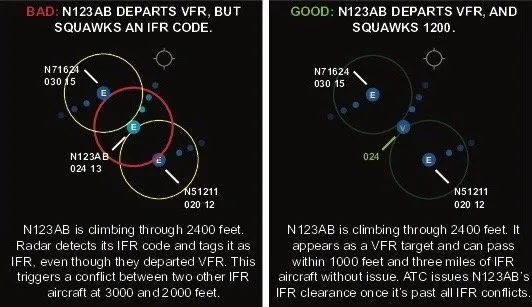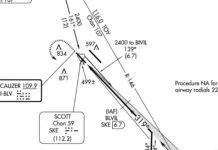You’ve had a good day so far. A friend invited you over for lunch and you took him up on the offer. You flew into a non-towered airport in his town, spent the afternoon catching up over a nice lunch, and now it’s time to head home.
With an IFR flight plan already filed to your home base, you fire up and get on the radio while still at the FBO. There’s no tower, but there is a clearance delivery frequency. The controller sounds a little hurried as you get your clearance—including a squawk code, of course—and tells you, “Hold for release. Report number one and ready to go.”
As you taxi out and near the runway approach end, you call ATC again, reporting, “Ready to go, Runway 9, number one.” ATC responds. “N123AB, I’m handling traffic at another airport. I’ll get back to you when I can.” He sounds like he’s got something going on. No release for now.
You’re holding short and a Cessna 172 taxis up behind you, announcing they’re looking to go VFR into the pattern. You’re blocking their path, so you reach out to ATC. No response. You try a couple more times. The airplane behind you tells you, “Hey, sometimes the clearance freq here can be a little unreliable.” Great. Now what?
Communication Relocation
Disclaimer: Of the following courses of action, none is a single, absolute correct answer. They’re simply different techniques to resolve the same situation. Airports and ATC facilities vary significantly in their environments and communication availability, often requiring different actions for the same result. Like adding up to 10, the equation may not always be 5 + 5. At another airport, it could be 7 + 3, or 2 + 8.
You could taxi onto the runway and get off at the next taxiway, letting the Cessna depart. There’s no need for him to burn his time and money waiting for your release, and this could help both of you.
How does it work to your advantage? Radio coverage is apparently an issue at this airport. Moving to a different spot could solve that issue. After all, ATC was able to hear you fine by the FBO. Taxiing back towards it may work to your advantage.
What’s the risk? You could be making that turn off from the runway onto the taxiway when ATC picks that moment to finally release you. “N123AB, released for departure. When entering controlled airspace, fly heading 050. Clearance void if not off in five minutes.”
Of course, you’re not at the hold short line anymore. Depending on the airport’s layout, getting back to the runway could take some time. Maybe someone else taxied in front of you, further delaying your departure.
While they may not have heard you, you did perform your due diligence. Just be straight with the controller: “I called ready three times, got no response, and then had to taxi out of someone’s way. I’ll be back at the runway shortly. Could I have a couple extra minutes on the void time?”
It’s likely—but not guaranteed—that ATC will accommodate some extra time for you. You’ve already been inconvenienced, after all. Unless there’s a pressing conflict (most likely other IFR traffic inbound to the airport), you’ll likely get that extension. “Clearance void if not off in ten minutes.”
Putting It Out There
What if you still can’t reach ATC via radio? AIM 5-2-7 (b) says, “If practical, pilots departing uncontrolled airports should obtain IFR clearances prior to becoming airborne when two-way communications with the controlling ATC facility is available.” It’s clearly not proving practical.
Another option? Just depart VFR, weather permitting. That’ll also help out the guy behind you. Perhaps you’re thinking, “Wait! I already got an IFR clearance and was told to hold for release. Will I cause trouble if I just depart?” The answer is no … unless you do it incorrectly.
Still got section 5-2-7 of the AIM open? Check out paragraph 5-2-7.a.2. “When ATC states in the clearance, ‘hold for release,’ the pilot may not depart utilizing that IFR clearance until a release time or additional instructions are issued by ATC.” Without a release, you may not depart “utilizing that IFR clearance.” That specific IFR clearance. It doesn’t apply if you’re departing VFR, since you’re not using that IFR clearance.
The key here is to depart fully 100 percent VFR. Remember that squawk code you were issued in the clearance? Keep it handy, but wipe it from your transponder. Squawk 1200 instead. By departing VFR, you’re in essence voiding the original IFR clearance, and the assigned code was part of that clearance. ATC will have to reissue you the clearance and squawk in the air anyway.
What happens if you depart on the original IFR squawk? In a word: confusion. While, you are technically VFR—you voided your clearance by departing VFR—ATC’s radar doesn’t know that. It’ll still detect that IFR squawk and tag you up on the scope as if you were on that IFR clearance. An unexpected IFR target popping up amidst their other IFR traffic is a real distraction to a controller, especially if it’s an aircraft who was expected to hold for release.
ATC radars feature extensive monitoring systems, among them the Terminal Analysis and Review Program (TARP). If you depart and suddenly tag up less than 3 miles or 1000 feet from another IFR aircraft—i.e. less than minimum IFR radar separation—the TARP will think the controller’s had an operational error. The TARP—or “snitch” as controllers (ahem) lovingly call it—will generate a report. Someone must then review the radar and audio logs to verify you were actually VFR and no error occurred.
Squawking VFR on departure alleviates all of those headaches. Now, there is actually one thing you could use from the IFR clearance: the departure frequency. ATC expected you to call them on that frequency anyway. After squawking 1200 and taking off, call them on it. “Departure, N123AB off of [airport]. We couldn’t reach you on the ground and departed VFR. Requesting our IFR clearance to [destination].” Emphasize the “departed VFR” so they know your status.
Call the Middle Man
What if immediately departing VFR isn’t an option? Ceilings and/or visibility below VFR minimums would certainly nix that option. However, the situation may not always be so black-and-white.
Perhaps there’s a solid two thousand foot overcast, and the airport’s bracketed by terrain that extends well above the cloud bases. Two thousand feet may be just fine for the guy behind you looking to just beat around the immediate traffic pattern. That might not be good enough for you, if you’re not that familiar with the area and don’t feel comfortable flying beyond the airport’s vicinity with mountains lurking in the mist. A good, safe initial heading from ATC and a clearance to continue climbing through the clouds would alleviate your concerns.
Given that direct radio comms with ATC aren’t working, let’s get a third party involved: Flight Service. If the airport has an available FSS frequency, great, and hopefully it’s working better than the ATC clearance frequency. If there’s no working frequency, just call them via cell phone. Hopefully you’ve got cell phone coverage.
When you contact FSS, make sure to tell them you’ve already got your clearance. “N123AB is on the ground at [departure airport name and identifier]. We’ve already received our IFR clearance to [destination airport name and identifier] and are holding for release. We were unable to reach [relevant ATC approach control/center] on the appropriate frequencies and are requesting IFR release off Runway [runway number]. We’re ready to go now/in [number of minutes].” This way, you’re cutting to the chase and letting them know all you need is the release.
Once you’ve communicated your request, FSS will then call the appropriate ATC facility via landline to request the release. These aren’t regular phones, but dedicated ATC coordination voice lines, which are all recorded for legal purposes. They ring inside the radar room.
When a controller answers, FSS will coordinate your release with them. Since you already had a clearance issued, your flight plan hopefully shouldn’t be too hard to track down. ATC will issue a release, departure instructions, and a void time. FSS relays all that to you, and off you go. (Note: This whole FSS relay race can take a while, so it’s probably best to go ahead and taxi around behind the Cessna while sorting through it.)
Straight to the Source
What else? Call the ATC facility directly via regular phone, bypassing FSS? The airport’s Chart Supplement listing might have a phone number under “COMM/NAV/WEATHER REMARKS”. An example? Rust airport in Woolsey, GA (3RU) has these remarks: “For Clnc Del ctc Atlanta Apch at 678-364-6131.”
That number rings at Atlanta Approach. The answering controller will make sure you’re on a recorded line and issue your clearance and hold time. When you’re ready to go, call back, and they’ll give you a release and void time. Like with FSS, this might take a bit.
Realistically, using that phone number is just about as good as a dedicated clearance frequency. You’re talking directly to the facility who will work you—no middle man. It’s actually preferred over FSS (for a clearance, not weather briefings or flight plan filing). For instance, Panacea airport (2J0) in Florida lists this: “For Clnc Del ctc Tallahassee Apch at 850-942-8311. If unable, ctc FSS.”
I’d like to stress that there’s no particular order to trying all of these methods. Maybe you just depart VFR and grab the clearance airborne. Maybe you try the facility number first. If you can’t raise them, you try FSS. Around the FBO, before you fire up, ask the locals and see what works best around that field. After all, it was that local Cessna pilot who warned you about the known frequency issues.
Also, no matter how you go about it, consider making just one call. It’s often easier for you and for the controller if you call for your clearance when you’re already at the runway. Of course, the risk here is that if you get an unexpected complex clearance it’ll take you time to prepare for it.
One last note: if something is supposed to be working, but isn’t—like the clearance frequency on the ground at your departure airport—tell ATC, whenever you do reach them. Radios and other hardware break. Human error may have disabled the freq by accident. ATC may not be aware of the issue until you say something. If no one knows it’s broken, it won’t get fixed.
Whatever the case, be patient and creative. Recognize that you’ve likely got multiple options available to you. Run down the list until you find the one that works, and be conscientious of other pilots while you work the problem.

Flight at the Improv
When a controller issues a non-towered airport IFR release, it typically follows a format like this: “N123AB released for departure. When entering controlled airspace, fly heading [degrees]. Clearance void if not off in [number of] minutes (or by a specified Zulu time). If not off in/by [minutes/time], advise [ATC facility] of intentions within/by [minutes/time].”
There are many elements in there and they can get a little jumbled during readbacks. Unfortunately, some pilots take the ad-libbing too far, starting their readback with: “N123AB is cleared for takeoff. When entering controlled airspace…”
Whoa. Was there a takeoff clearance in the original version? Nope. I realize it’s likely a readback habit stemming from flying out of towered airports. However, non-towered airports are a different animal, with different liabilities, and ATC can’t let a slip like that slide.
When a towered airport’s controller says, “Cleared for takeoff,” it’s not just a neat phrase. A lot of thought goes into it. They visually scan the runway for threats, ensuring nothing’s on the runway. That scan also includes the final and the departure airspace. If someone’s on final, they must notify them that you’re departing. They also must notify you of any mowers or personnel and equipment operating near the runway, unless they’re on the ATIS.
If you’re departing a non-towered airport, no one is doing all those checks but you. ATC can’t see you, the runway environment, or if there’s airborne traffic in the immediate area that could impact you. However, if you read back, “Cleared for takeoff,” ATC doesn’t correct it, and you collide with another aircraft on the runway, ATC could bear liability for that collision.
Therefore, ATC must correct the readback. I’ve lost track of how many times I’ve had to say, “Negative, N123AB, you are not cleared for takeoff. You’re departing a non-towered airport and are released for departure.” It’s a reminder that no one has eyes on them until the radar controller identifies their target and says, “Radar contact.” As they taxi, take the runway, and depart, they’re still responsible for broadcasting all the appropriate position reports and separating themselves from traffic in the airport’s vicinity. —TK
Tarrance Kramer likes to keep his options open while working air traffic out in the MidWest.




